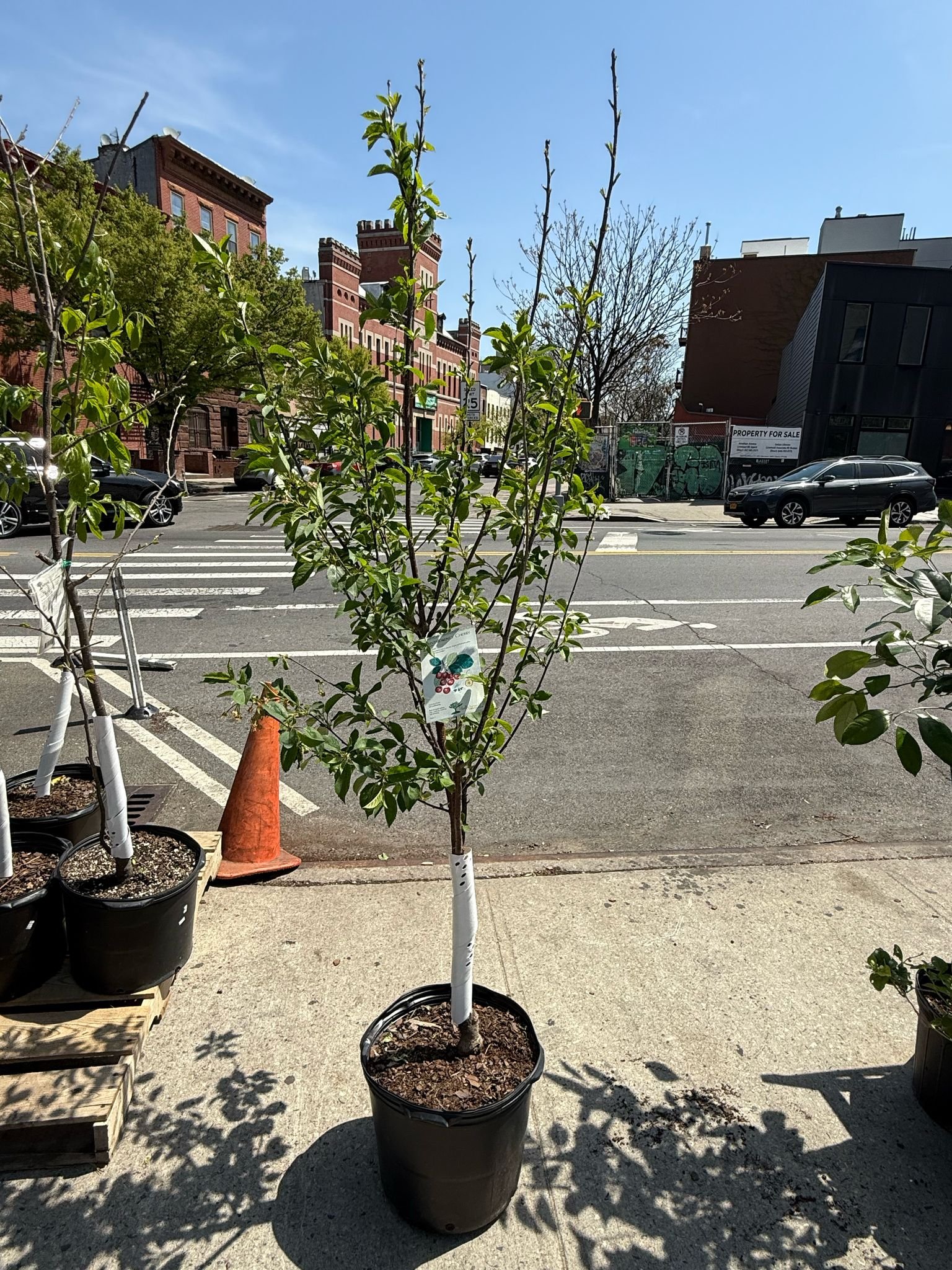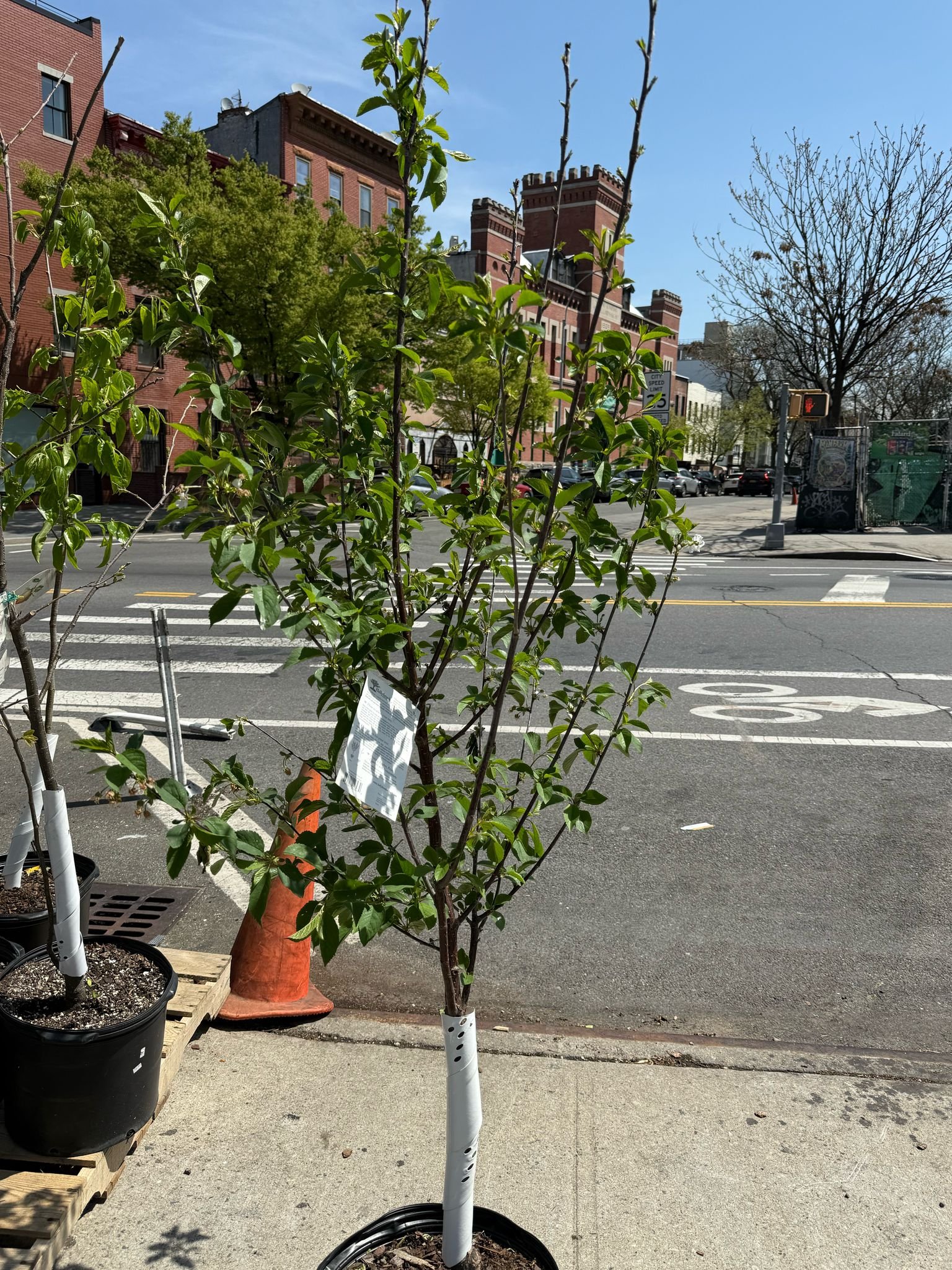 Image 1 of 3
Image 1 of 3

 Image 2 of 3
Image 2 of 3

 Image 3 of 3
Image 3 of 3




Montmorency Cherry Tree Prunus cerasus ‘Montmorency’
Montmorency Cherry Tree
Prunus cerasus ‘Montmorency’
The Montmorency Cherry is the classic sour cherry variety, beloved for its vibrant red fruit and tart flavor. Known as the best variety for baking and making preserves, Montmorency cherries shine in pies, jams, and even savory dishes. This self-pollinating tree thrives in cooler climates, making it a favorite for northern gardeners and home orchards.
Montmorency cherries are not just tasty but also beautiful — they bloom in early spring with delicate white flowers and produce heavy crops of bright red cherries in mid-summer. This hardy tree has a compact size, perfect for smaller yards, and with proper care, it can be a long-lasting addition to your garden.
🌿 Care & Growing Info:
Light: Full sun — at least 6 hours daily for the best fruit production
Soil: Well-drained, loamy soil. Prefers slightly acidic to neutral pH
Watering: Moderate — deep watering during dry spells and while the tree is establishing
Fertilizing: Feed in early spring with a balanced fertilizer to support strong growth and fruiting
Pruning: Prune after harvest to maintain shape and improve airflow. Remove dead or diseased wood during the dormant season
Pests/Disease: Generally resistant to most diseases, though watch for occasional cherry pests
📅 Seasonal Highlights:
Spring: Beautiful white blossoms that attract pollinators and signal the start of the growing season
Summer: Cherries begin to ripen, typically in mid-June to early July
Fall: Leaves turn golden-yellow, and the tree prepares for winter dormancy
Winter: Dormant period. A good time to prune and shape the tree
🌳 Tree Details:
Mature Size: 10–15 ft tall
Spacing: 10–15 ft apart
Hardiness Zones: 4–8
Pollination: Self-pollinating (though a second tree may increase yields)
Harvest Time: Mid-summer (June–July)
Fruit: Small, round, bright red cherries with a tart, tangy flavor
Why Grow Montmorency Cherry:
Perfect for baking, jams, and pies with its classic tart flavor
Self-pollinating for easy fruiting
Compact tree ideal for small orchards or backyard gardens
Cold-hardy and reliable in northern climates
Montmorency Cherry Tree
Prunus cerasus ‘Montmorency’
The Montmorency Cherry is the classic sour cherry variety, beloved for its vibrant red fruit and tart flavor. Known as the best variety for baking and making preserves, Montmorency cherries shine in pies, jams, and even savory dishes. This self-pollinating tree thrives in cooler climates, making it a favorite for northern gardeners and home orchards.
Montmorency cherries are not just tasty but also beautiful — they bloom in early spring with delicate white flowers and produce heavy crops of bright red cherries in mid-summer. This hardy tree has a compact size, perfect for smaller yards, and with proper care, it can be a long-lasting addition to your garden.
🌿 Care & Growing Info:
Light: Full sun — at least 6 hours daily for the best fruit production
Soil: Well-drained, loamy soil. Prefers slightly acidic to neutral pH
Watering: Moderate — deep watering during dry spells and while the tree is establishing
Fertilizing: Feed in early spring with a balanced fertilizer to support strong growth and fruiting
Pruning: Prune after harvest to maintain shape and improve airflow. Remove dead or diseased wood during the dormant season
Pests/Disease: Generally resistant to most diseases, though watch for occasional cherry pests
📅 Seasonal Highlights:
Spring: Beautiful white blossoms that attract pollinators and signal the start of the growing season
Summer: Cherries begin to ripen, typically in mid-June to early July
Fall: Leaves turn golden-yellow, and the tree prepares for winter dormancy
Winter: Dormant period. A good time to prune and shape the tree
🌳 Tree Details:
Mature Size: 10–15 ft tall
Spacing: 10–15 ft apart
Hardiness Zones: 4–8
Pollination: Self-pollinating (though a second tree may increase yields)
Harvest Time: Mid-summer (June–July)
Fruit: Small, round, bright red cherries with a tart, tangy flavor
Why Grow Montmorency Cherry:
Perfect for baking, jams, and pies with its classic tart flavor
Self-pollinating for easy fruiting
Compact tree ideal for small orchards or backyard gardens
Cold-hardy and reliable in northern climates
Montmorency Cherry Tree
Prunus cerasus ‘Montmorency’
The Montmorency Cherry is the classic sour cherry variety, beloved for its vibrant red fruit and tart flavor. Known as the best variety for baking and making preserves, Montmorency cherries shine in pies, jams, and even savory dishes. This self-pollinating tree thrives in cooler climates, making it a favorite for northern gardeners and home orchards.
Montmorency cherries are not just tasty but also beautiful — they bloom in early spring with delicate white flowers and produce heavy crops of bright red cherries in mid-summer. This hardy tree has a compact size, perfect for smaller yards, and with proper care, it can be a long-lasting addition to your garden.
🌿 Care & Growing Info:
Light: Full sun — at least 6 hours daily for the best fruit production
Soil: Well-drained, loamy soil. Prefers slightly acidic to neutral pH
Watering: Moderate — deep watering during dry spells and while the tree is establishing
Fertilizing: Feed in early spring with a balanced fertilizer to support strong growth and fruiting
Pruning: Prune after harvest to maintain shape and improve airflow. Remove dead or diseased wood during the dormant season
Pests/Disease: Generally resistant to most diseases, though watch for occasional cherry pests
📅 Seasonal Highlights:
Spring: Beautiful white blossoms that attract pollinators and signal the start of the growing season
Summer: Cherries begin to ripen, typically in mid-June to early July
Fall: Leaves turn golden-yellow, and the tree prepares for winter dormancy
Winter: Dormant period. A good time to prune and shape the tree
🌳 Tree Details:
Mature Size: 10–15 ft tall
Spacing: 10–15 ft apart
Hardiness Zones: 4–8
Pollination: Self-pollinating (though a second tree may increase yields)
Harvest Time: Mid-summer (June–July)
Fruit: Small, round, bright red cherries with a tart, tangy flavor
Why Grow Montmorency Cherry:
Perfect for baking, jams, and pies with its classic tart flavor
Self-pollinating for easy fruiting
Compact tree ideal for small orchards or backyard gardens
Cold-hardy and reliable in northern climates
